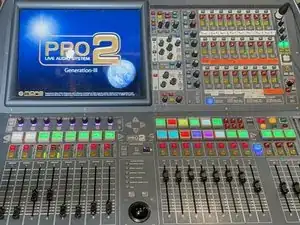
CMOS Battery
These are some common tools used to work on this device. You might not need every tool for every procedure.
An audio mixer, also known as a mixing console, soundboard, or mixing desk, is a device used in audio production and live sound reinforcement to combine and control the levels, timbre, and effects of multiple audio signals. It is an essential tool for musicians, sound engineers, DJs, and audio technicians.
The primary function of an audio mixer is to take multiple audio inputs and blend them together into a coherent and balanced output signal. These inputs can come from various sources such as microphones, musical instruments, CD players, computers, or other audio playback devices. The mixer allows you to adjust the volume, pan position (the stereo placement), equalization (tone control), and apply effects to each input signal.
Audio mixers come in different sizes and configurations, ranging from small portable mixers with just a few channels to large-scale mixing consoles with dozens or even hundreds of channels. They typically feature multiple input channels, each equipped with volume faders, equalizers, and auxiliary sends for creating monitor mixes or applying effects. They also include output sections with master faders and additional controls for overall level adjustment and routing the mixed audio to various destinations such as speakers, recorders, or broadcast systems.
In addition to basic level and tone control, advanced audio mixers may offer features like built-in effects processors, digital signal processing (DSP) capabilities, automation, and connectivity options for computer integration. Some mixers also provide additional functionalities like sub-grouping channels, routing options, and advanced monitoring capabilities to meet the specific needs of different audio production scenarios.
Audio mixers typically feature multiple input channels, each equipped with a preamplifier, also known as a preamp. The preamp boosts the low-level audio signals received from microphones or other audio sources to a suitable level for further processing. Each channel usually includes controls for adjusting gain, pan (left-right balance), and routing options.
Faders are sliding controls found on an audio mixer that allow an engineer to adjust the volume or level of each individual audio channel. They are usually arranged in a vertical layout, with each fader corresponding to a specific channel. Other controls, such as knobs, buttons, and switches, are provided to adjust parameters like equalization (EQ), auxiliary sends, panning, and effects.
Equalization is a fundamental audio processing tool used to shape the tonal characteristics of audio signals. Audio mixers often include dedicated EQ controls for each channel, allowing the adjustment of frequency bands to enhance or reduce specific frequencies. Typical EQ controls consist of sliders or knobs for adjusting bass, midrange, and treble frequencies.
Auxiliary (aux) sends are additional outputs on an audio mixer that can be used to send audio signals to external devices, such as effects processors, monitor speakers, or recording devices. Each aux send is usually equipped with a dedicated control to determine the amount of signal sent from each channel.
Audio mixers may have bus outputs or subgroup outputs, which provide a way to group multiple audio channels together. These outputs enable the routing of combined audio signals to other devices or processing units, such as additional mixers or recording interfaces. Buses and subgroups can be used to control the level and processing of multiple channels simultaneously.
The master section of an audio mixer includes controls for the overall mix. It typically consists of the main stereo faders, master faders, and additional controls for the master output, such as a master EQ, main output level control, and metering.
Audio mixers come in various types and sizes, catering to different applications and needs. Some common types include:
Analog mixers process audio signals using analog circuitry and are characterized by physical knobs, faders, and switches. They are known for their warm and often sought-after sound characteristics. Analog mixers are available in different configurations, ranging from small portable mixers to large-format consoles used in professional studios.
Digital mixers convert audio signals into digital data for processing, offering a wide range of advanced features and capabilities. They provide precise control, extensive signal routing options, onboard effects processing, recallable settings, and the ability to store and recall presets. Digital mixers are commonly used in live sound applications due to their flexibility and scalability.
Software mixers, also known as virtual mixers or digital audio workstations (DAWs), are computer-based applications that emulate the functionality of hardware mixers.